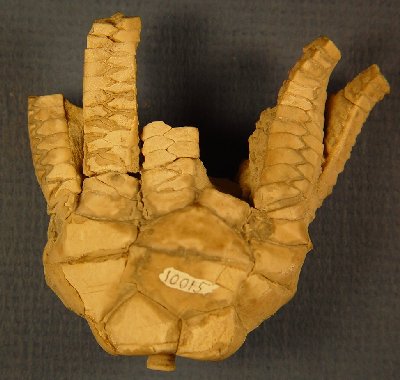
Delocrinus vastus
Description: "Delocrinus vastus" (Lane and Webster, 1966). Gary Lane and Gary Webster described this species from a sample of silicified crinoids of Permian age that they collected from a remote site called Battleship Wash in Nevada. These grew to be large crinoids with cups having a diameter of up to 40-mm (ca. 1.5 in) or more. The robust nature of the crown and the pinnulated, branching arms suggest they preferred to live in fairly warm, shallow water with an abundant food supply that was suspended in the water column. (See Pabian and Strimple, 1969, 1985: Heckel and Pabian, 1981, and Holterhoff, 1988, 1996 for details). Hence, these crinoids are suspension feeders. "D. vastus" shared its environment with several other species of crinoids including "Nebraskacrinus tourteloti" Moore & Plummer and "Microcaracrinus twenhofeli" (Moore), and several species of suspension feeding brachiopods of the genera "Composita" and "Derbyia", the free-swimming bivalve, "Aviculopecten" and the burrowing clam, Wilkingia. Pabian and Strimple (1974) described additional specimens of "D. vastus" from the Grant Shale in Gage County and (1978) the older Hughes Creek Shale member of the Foraker Formation in Richardson County.
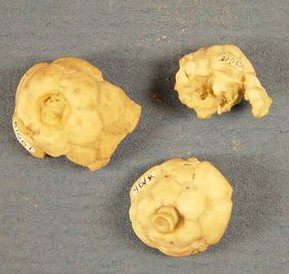
Microcaracrinus twenhofeli
Description: "Microcaracrinus twenhofeli" Moore, 1938. This species was first described as a species of "Pachylocrinus"; subsequent revision of the family "Blothrocrinidae" led Harrell Strimple and William Watkins (1969) to erect a new genus, "Microcaracrinus", meaning small-headed crinoid. In 1973, Strimple and R. C. Moore described a lagerstaaten deposit (mother lode) of crinoids from the Pennsylvanian of Illinois and they assigned "Pachylocrinus twenhofeli" Moore to the genus "Microcaracrinus" and "P. twenhofeli" Moore became "M. twenhofeli" (Moore). Moore's name appears in parenthesis in the latter designation because the species was moved to a genus other than the one in when it was originally described. That is why you sometimes see the species authors' names in or out of parentheses. Crowns of "M. twenhofeli" are somewhat smaller than crowns of either "Delocrinus vastus" Lane and Webster or "Nebraskacrinus tourteloti" Moore and they may have occupied a slightly different niche, perhaps a smaller distance above the substrate, than the latter. "Microcaracrinus twenhofeli" Moore, three cups, one with lower arms intact. This is the smallest and rarest crinoid to have been found in the Grant Shale in Gage County.
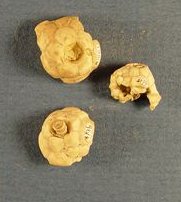
Microcaracrinus twenhofeli
Description: "Microcaracrinus twenhofeli" Moore, 1938. This species was first described as a species of "Pachylocrinus"; subsequent revision of the family "Blothrocrinidae" led Harrell Strimple and William Watkins (1969) to erect a new genus, "Microcaracrinus", meaning small-headed crinoid. In 1973, Strimple and R. C. Moore described a lagerstaaten deposit (mother lode) of crinoids from the Pennsylvanian of Illinois and they assigned "Pachylocrinus twenhofeli" Moore to the genus "Microcaracrinus" and "P. twenhofeli" Moore became "M. twenhofeli" (Moore). Moore's name appears in parenthesis in the latter designation because the species was moved to a genus other than the one in when it was originally described. That is why you sometimes see the species authors' names in or out of parentheses. Crowns of "M. twenhofeli" are somewhat smaller than crowns of either "Delocrinus vastus" Lane and Webster or "Nebraskacrinus tourteloti" Moore and they may have occupied a slightly different niche, perhaps a smaller distance above the substrate, than the latter. "Microcaracrinus twenhofeli" Moore, three cups, one with lower arms intact. This is the smallest and rarest crinoid to have been found in the Grant Shale in Gage County.
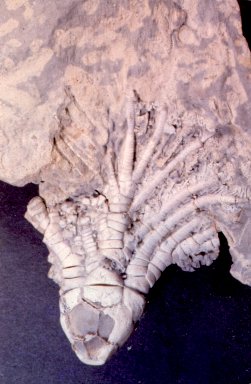
Nebraskacrinus tourteloti
Description: "Nebraskacrinus tourteloti" Moore, 1938. Raymond C. Moore of the University of Kansas described "Nebraskacrinus tourteloti" in 1939 on the basis of a partial crown collected by H. Allison Tourtelot from the Grant Shale Member of the Winfield Formation exposed in Gage County, Nebraska. Moore and J. M. Jewett of the Kansas Geological Survey collected additional specimens from near Bala, Riley County, Kansas. Moore subsequently described many other species of Pennsylvanian and Permian crinoids but "N. tourteloti" probably remained his favorite throughout his lifetime. "N. tourteloti" appears to have a very short stratigraphic range and a fairly small geographic distribution that limits its utility as an index fossil. The robust crown with complex branching, pinnulated arms suggest that it was a suspension feeder that preferred fairly warm, shallow water with abundant food supplies.
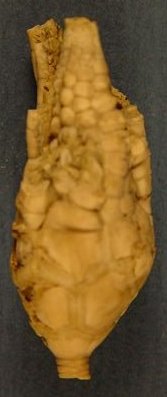
Nebraskacrinus tourteloti
Description: "Nebraskacrinus tourteloti" Moore, 1938. Raymond C. Moore of the University of Kansas described "Nebraskacrinus tourteloti" in 1939 on the basis of a partial crown collected by H. Allison Tourtelot from the Grant Shale Member of the Winfield Formation exposed in Gage County, Nebraska. Moore and J. M. Jewett of the Kansas Geological Survey collected additional specimens from near Bala, Riley County, Kansas. Moore subsequently described many other species of Pennsylvanian and Permian crinoids but "N. tourteloti" probably remained his favorite throughout his lifetime. "N. tourteloti" appears to have a very short stratigraphic range and a fairly small geographic distribution that limits its utility as an index fossil. The robust crown with complex branching, pinnulated arms suggest that it was a suspension feeder that preferred fairly warm, shallow water with abundant food supplies. "Nebraskacrinus tourteloti" Moore, posterior of partial crown showing anal tube that is normally concealed by the crinoid's arms.
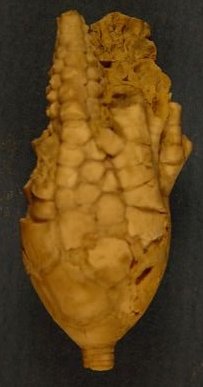
Nebraskacrinus tourteloti
Description: "Nebraskacrinus tourteloti" Moore, 1938. Raymond C. Moore of the University of Kansas described "Nebraskacrinus tourteloti" in 1939 on the basis of a partial crown collected by H. Allison Tourtelot from the Grant Shale Member of the Winfield Formation exposed in Gage County, Nebraska. Moore and J. M. Jewett of the Kansas Geological Survey collected additional specimens from near Bala, Riley County, Kansas. Moore subsequently described many other species of Pennsylvanian and Permian crinoids but "N. tourteloti" probably remained his favorite throughout his lifetime. "N. tourteloti" appears to have a very short stratigraphic range and a fairly small geographic distribution that limits its utility as an index fossil. The robust crown with complex branching, pinnulated arms suggest that it was a suspension feeder that preferred fairly warm, shallow water with abundant food supplies. "Nebraskacrinus tourteloti" Moore, posterior of partial crown showing anal tube that is normally concealed by the crinoid's arms.
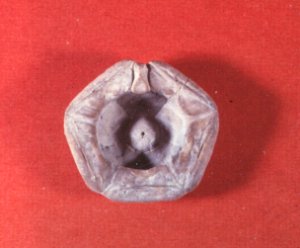
Diphuicrinus
Description: "Diphuicrinus" sp., dorsal cup, summit view.
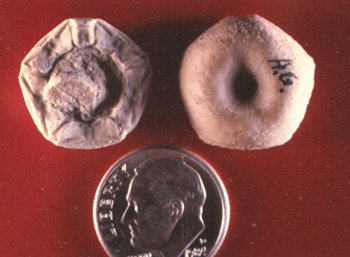
Delocrinus vulgatus
Description: "Delocrinus vulgatus" Moore and Plummer, dorsal cups, summit and basal views.
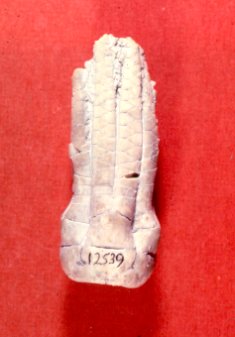
Delocrinus vulgatus
Description: "Delocrinus vulgatus" Moore and Plummer, crown, anterior view, height is approximately 65 mm.
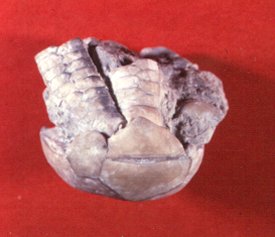
Delocrinus vulgatus
Description: Delocrinus vulgatus Moore and Plummer, partial crown, posterior view, cup diameter is approximately 30 mm.
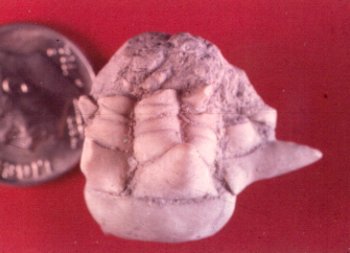
Delocrinus vulgatus
Description: "Delocrinus vulgatus" Moore and Plummer, immature partial crown, anterior view.
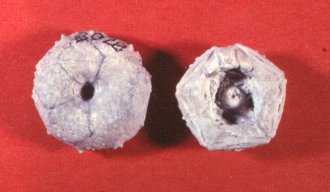
Graffhamicrinus magnificus
Description: "Graffhamicrinus magnificus" (Strimple), dorsal caps, basal and summit views, approximate diameter is 28 mm.
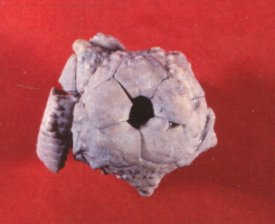
Graffhamicrinus magnificus
Description: Graffhamicrinus magnificus (Strimple), partial crown, basal view, cup diameter is approximately 28 mm.
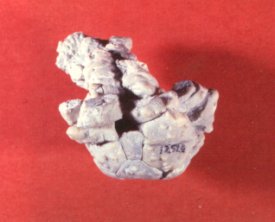
Graffhamicrinus magnificus
Description: Graffhamicrinus magnificus (Strimple), partial crown, posterior view, cup diameter is approximately 28 mm.
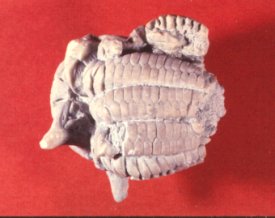
Graffhamicrinus magnificus
Description: Graffhamicrinus magnificus (Strimple), partial crown, basal v iew, cup diameter is approximately 35 mm.
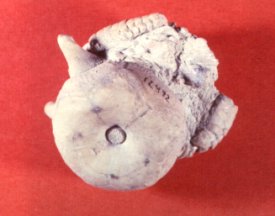
Graffhamicrinus magnificus
Description: Graffhamicrinus magnificus (Strimple), partial crown, summit view, cup diameter is approximately 35 mm.

Graffhamicrinus stullensis
Description: "Graffhamicrinus stullensis" (Strimple), dorsal cup with primibrachials attached, basal view, cup diameter is approximately 30 mm.

Parulocrinus blairi
Description: "Parulocrinus blairi" Miller and Gurley, dorsal cup, summit view, approximate diameter is 38 mm.
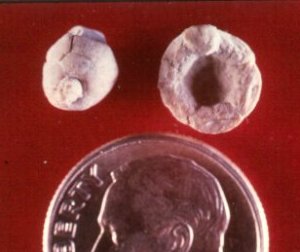
Alossocrinus bronaughi
Description: "Alossocrinus bronaughi" Strimple, dorsal cups.
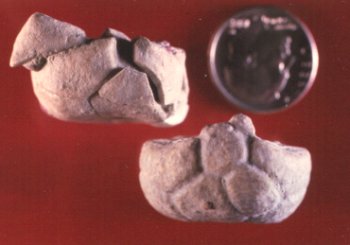
Aglaocrinus comactus
Description: "Aglaocrinus comactus" (Moore and Plummer), dorsal cups.
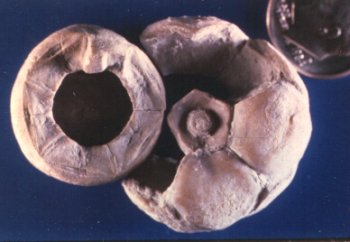
Aglaocrinus comactus
Description: "Aglaocrinus comactus" (Moore and Plummer), dorsal cups.
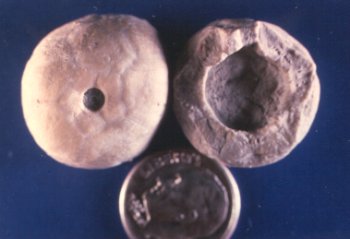
Aglaocrinus comactus
Description: "Aglaocrinus comactus" (Moore and Plummer), dorsal cups.
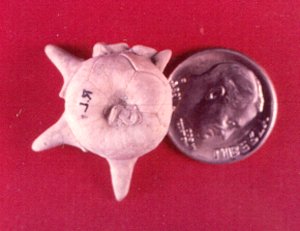
Delocrinus subhemisphericus
Description: "Delocrinus subhemisphericus" Moore and Plummer, partial crown.
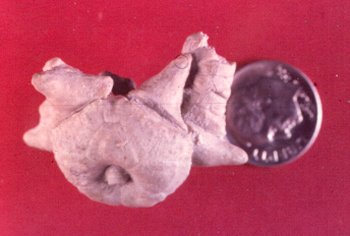
Delocrinus subhemisphericus
Description: "Delocrinus subhemisphericus" Moore and Plummer, partial crown.
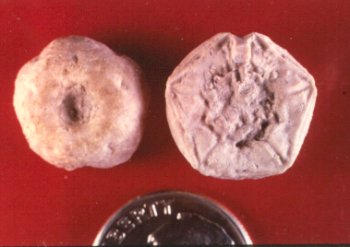
Delocrinus subhemisphericus
Description: "Delocrinus subhemisphericus" Moore and Plummer, dorsal cups.
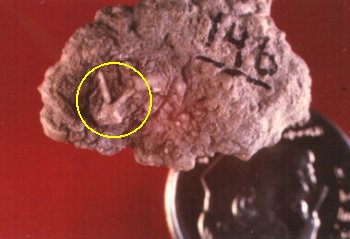
Erisocrinus typus
Description: "Erisocrinus typus" Meek and Worthen, juvenile crown.
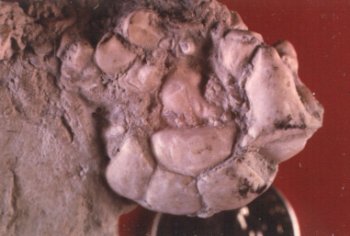
Glaukosocrinus
Description: "Glaukosocrinus" sp.
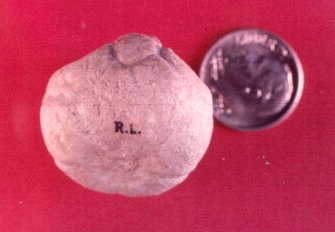
Parulocrinus blairi
Description: "Parulocrinus blairi" (Miller and Gurley), dorsal cups.
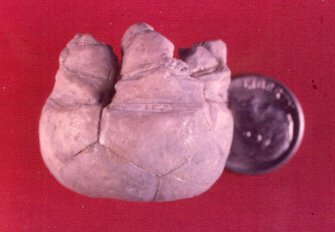
Parulocrinus blairi
Description: "Parulocrinus blairi" (Miller and Gurley), partial crown.
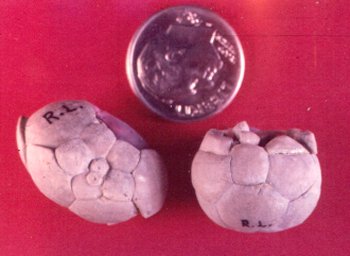
Polusocrinus rosae
Description: "Polusocrinus rosae", dorsal cups.
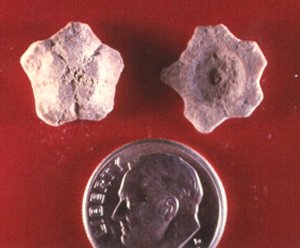
Schistocrinus sp. cf. confertus
Description: "Schistocrinus sp. cf. confertus" Moore and Plummer, infrabasal circlets.
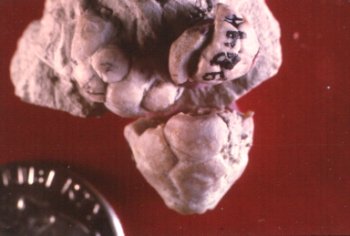
Terpnocrinus ellipticus
Description: "Terpnocrinus ellipticus" Pabian and Strimple, dorsal cups.
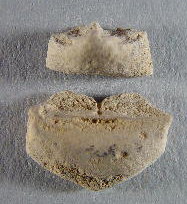
Aglaocrinus sp.
Description: "Aglaocrinus sp." - Radial and primibrachial plates.
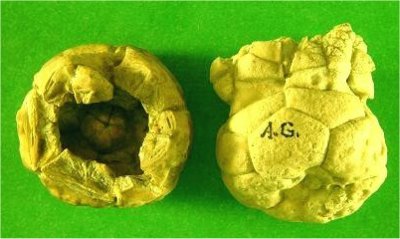
Ethelocrinus sp. cf. magister
Description: "Ethelocrinus sp. cf. magister" (Miller and Gurley) - Summit view of doral cup and anterior view of partial crown.
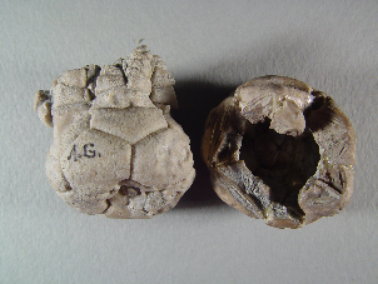
Ethelocrinus sp. cf. magister
Description: "Ethelocrinus sp. cf. magister" (Miller and Gurley) - Summit and basal view of cup.
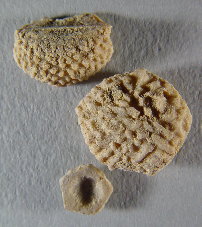
Ethelocrinus sp. cf. magister
Description: "Ethelocrinus sp. cf. magister" (Miller and Gurley) - Infrabasal circlet (below), basal plate, and radial plate (above).